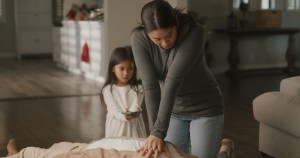Bystander CPR Up To 10 Minutes After Cardiac Arrest May Protect Brain Function
 The sooner a lay rescuer (bystander) starts cardiopulmonary resuscitation (CPR) on a person having a cardiac arrest at home or in public, up to 10 minutes after the arrest, the better the chances of saving the person’s life and protecting their brain function, according to preliminary research to be presented at the American Heart Association’s Resuscitation Science Symposium 2024. The meeting will be held Nov. 16-17, 2024, at the Hilton Chicago Hotel in Chicago and will feature the most recent advances related to treating cardiopulmonary arrest and life-threatening traumatic injury.
The sooner a lay rescuer (bystander) starts cardiopulmonary resuscitation (CPR) on a person having a cardiac arrest at home or in public, up to 10 minutes after the arrest, the better the chances of saving the person’s life and protecting their brain function, according to preliminary research to be presented at the American Heart Association’s Resuscitation Science Symposium 2024. The meeting will be held Nov. 16-17, 2024, at the Hilton Chicago Hotel in Chicago and will feature the most recent advances related to treating cardiopulmonary arrest and life-threatening traumatic injury.
Cardiac arrest, which occurs when the heart malfunctions and abruptly stops beating, is often fatal without quick medical attention such as CPR to increase blood flow to the heart and brain. More than 357,000 out-of-hospital cardiac arrests happen each year in the U.S. with a 9.3% survival rate. “Our findings reinforce that every second counts when starting bystander CPR and even a few minutes delay can make a big difference,” said Evan O’Keefe, M.D., the study’s first author and a cardiovascular fellow at Saint Luke’s Mid America Heart Institute and the University of Missouri-Kansas City. “If you see someone in need of CPR, don’t dwell on how long they’ve been down, your quick actions could save their life.”
The study analyzed nearly 200,000 cases of witnessed out-of-hospital cardiac arrest to determine whether initiating CPR within different time windows, compared to outcomes with no bystander CPR administered, made a difference in survival and brain function after hospital discharge.
“We found that people who received bystander CPR within the first few minutes of their cardiac arrest were much more likely to survive and have better brain function than those who didn’t,” O’Keefe said. “The longer it took for CPR to start, the less survival benefit one received. However, even when CPR was started up to 10 minutes after cardiac arrest, there was still a significant survival benefit compared to individuals who did not receive CPR from a bystander.”
Results also found:
- People who received CPR within two minutes of out-of-hospital cardiac arrest had an 81% higher rate of survival to release from the hospital and 95% higher rate of surviving without significant brain damage compared to people who did not receive bystander CPR.
- Even people who received bystander CPR up to 10 minutes after cardiac arrest were 19% more likely to survive to hospital discharge and 22% more likely to have a favorable neurological outcome than those who did not receive bystander CPR at all.
- For those who did not receive bystander CPR, about 12% survived to be released from the hospital, and more than 9% survived without significant brain damage or major disabilities. When bystander CPR was initiated more than 10 minutes after cardiac arrest, bystander CPR, compared to not receiving the lifesaving assistance, was no longer associated with improved survival.
“These results highlight the critical importance of quick action in emergencies. It suggests that we need to focus on teaching more people how to perform CPR, and we also need to emphasize ways to get help to those suffering cardiac arrest faster,” O’Keefe said. “This might include more widespread CPR training programs, as well as better public access to automated external defibrillators (AEDs) and improved dispatch systems.”
O’Keefe noted that future research could explore how technology (like apps that alert nearby trained bystanders or alert dispatchers to likely cardiac arrest) may help to reduce the time to first intervention, information that could be important for emergency dispatchers and policymakers in the development of public interventions for cardiac arrest.
“This study highlights the need for prompt recognition and treatment of cardiac arrest by bystanders. Time is of the essence when a cardiac arrest occurs, and late interventions can be as ineffective as no intervention. Community education and empowerment are critical for us to save lives,” said American Heart Association volunteer expert Anezi Uzendu, M.D., an interventional cardiologist at the University of Texas Southwestern Medical Center in Dallas and a cardiac arrest survivor.
The American Heart Association urges everyone learn the lifesaving skills of CPR and join its Nation of Lifesavers®, a movement to double survival rates from sudden cardiac arrest by 2030. Being ready to act quickly could be the difference of life or death for someone experiencing a cardiac arrest.
A limitation of the study includes that the average time of arrival for emergency medical technicians (EMTs) to the person having cardiac arrest was roughly 10 minutes. This means that in this study, the people who received bystander CPR 10 minutes after their cardiac arrest were likely being compared to a group receiving professional medical attention.
Short URL: https://caninechronicle.com/?p=310284
Comments are closed












